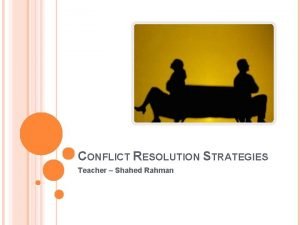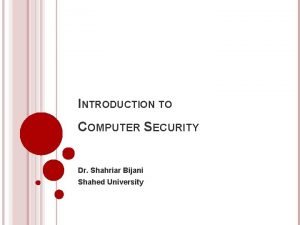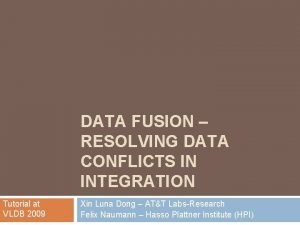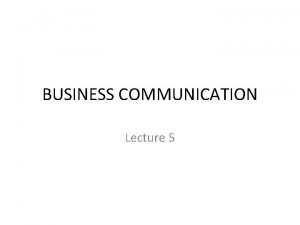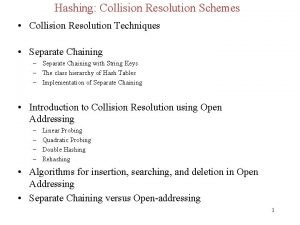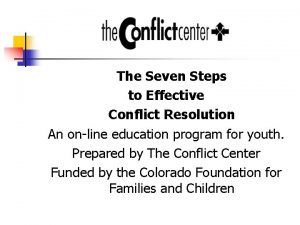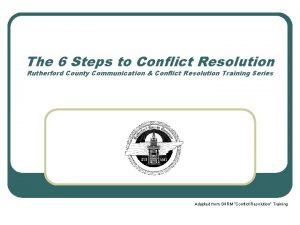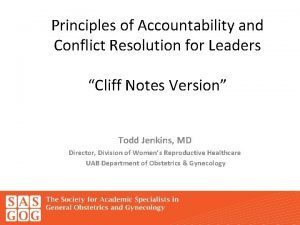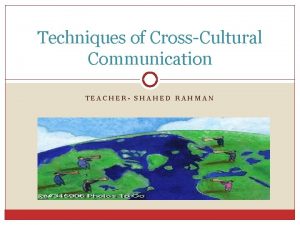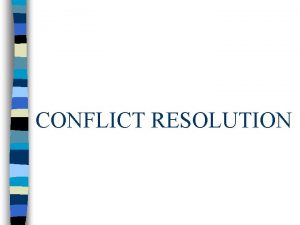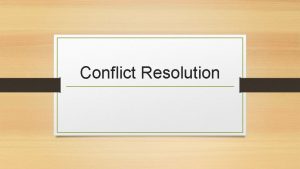CONFLICT RESOLUTION STRATEGIES Teacher Shahed Rahman INTRODUCTION Successful















- Slides: 15

CONFLICT RESOLUTION STRATEGIES Teacher – Shahed Rahman

INTRODUCTION Successful channel leaders are changing the nature and meaning of power and how it is employed to settle conflicts Five Types � Negotiation � Problem Solving Strategies � Persuasive Mechanisms � Legalistic Strategies � Climate Management

NEGOTIATION Negotiation involves discussions aimed at resolving conflict Negotiation is a fact of life in marketing channel It should be mastered rather than feared Procedural Steps for a Typical Negotiation Process: � Identify and Define the Problem � Get the Facts � Generate Possible Solutions � Evaluate Possible Solutions � Select Solutions � Implement the Solutions � Evaluate the Results

NEGOTIATION CAN BE

EVALUATING DESIRED RELATIONSHIP OUTCOME People and organizations often enter negotiations driven by self centered desires. Types of negotiation Strategy one chooses will directly affect the relationship The relative power of each channel member is roughly equivalent to that member’s dependence on the other Channel members should not select negotiating strategies until after they have evaluated what they and other channel members seek regarding the future of their relationship

CHOOSING A NEGOTIATION STRATEGY Predatory (Greedy) Negotiation � Channel member who use predatory negotiation generally consider as weak or unsophisticated the idea of relationship � sustaining bargaining sessions featuring information sharing, give and take, open communication, creativity and an attitude of cultivating the common good � Future relationship is considered less important than the gains

CHOOSING A NEGOTIATION STRATEGY Symbiotic Negotiation � Attempts to create mutual value through tradeoffs and bargaining. � Negotiators believe that conflict resolution is best achieved by being cooperative, imaginative, and persistent in the pursuit of mutual gains relative to the possibility of no agreement � WIN -WIN Strategy

FOR A WIN – WIN STRATEGY Separates the people from the problem � Separates the substantive elements of the issue under conflict from the personal relationships between the boundary personnel Focuses on needs rather than positions � Effective approach is to focus on the underlying human or organizational needs that caused boundary personnel to adopt their position in the first place Develops options for mutual gain � Do not just stick with one point Uses only objective criteria � Give the objectives and see they are willing to do this

ALWAYS REMEMBER FOR NEGOTIATION Do Their Homework Deal only from the top of the deck Remember that quitters never win and winners never quit Remember that attitude is everything Build Bridges (Relationship) rather than walls

A MATRIX OF LIKELY CONSEQUENCES TO CHANNEL NEGOTIATIONS Strategy of Channel Member A Symbiotic Consequences Good for Member A Good for Member B Predatory Strategy of Channel member B Symbiotic Consequences Excellent (in Short Run) For Member B Devastating for Member A Predatory Consequences Excellent (in Short Run) For Member A Devastating for Member B Consequences Standard for Member A Standard for Member B

PROBLEM SOLVING STRATEGIES Problem solving strategies are the actions taken to resolve the disputes , disagreements, or confrontation between the members of marketing channels Problem Solving Strategies Involve the pursuit of alternative solutions to the conflict in questions Three strategies � Compromise Strategy � Logrolling � Aggressive Strategy

LOGROLLING Each channel participant identifies its priorities and offers concessions on those issues it views as less significant Only occur if the manufacturer assigns a higher priority to price, while the retailer attaches greater importance to delivery Logrolling is the trading of favors

COMPROMISE STRATEGY Involves the resolution of conflicts by establishing a middle ground based on the initial position of both parties Several issues or concerns may be related to a given conflict It is based on appropriate or reciprocal (mutual) concessions from their initial positions by both parties

AGGRESSIVE STRATEGIES To work out problems by using threats, persuasive arguments or punishments In this case the objective is to extract through whatever means available , one sided concessions from the other channel member.

PERSUASIVE MECHANISMS The act of persuasion implies that one channel member influences another member’s behavior Viewed as something that is done with others Implies a cooperative effort a process of give and take. � Personal acceptance � Confirming Motivation � Dispensing Rewards
 Shahed rahman
Shahed rahman Dr bijani
Dr bijani Conflict resolution strategies
Conflict resolution strategies What is conflict and conflict resolution?
What is conflict and conflict resolution? Hafidz rahman teacher
Hafidz rahman teacher Strategies for successful interpersonal communication
Strategies for successful interpersonal communication Successful job search strategies
Successful job search strategies The key to a successful parent-teacher conference is
The key to a successful parent-teacher conference is High resolution low resolution
High resolution low resolution Collision resolution techniques
Collision resolution techniques Cudsa communication model stand for
Cudsa communication model stand for Work immersion in barangay
Work immersion in barangay How many rectangle
How many rectangle Six steps of conflict resolution
Six steps of conflict resolution Resident customer service
Resident customer service Accountability in conflict resolution
Accountability in conflict resolution
